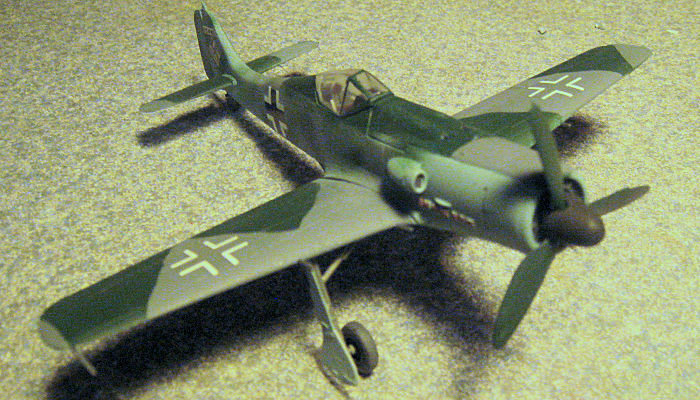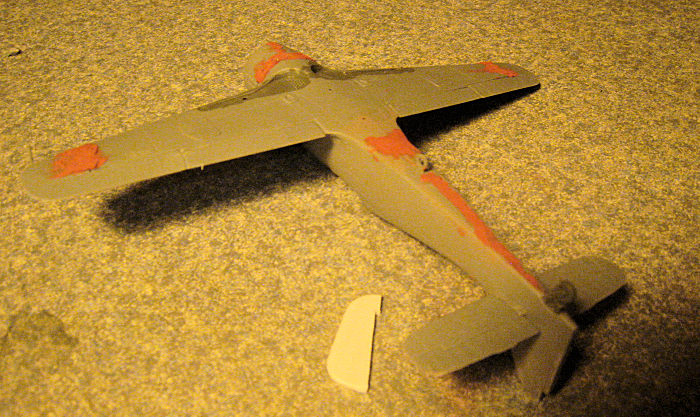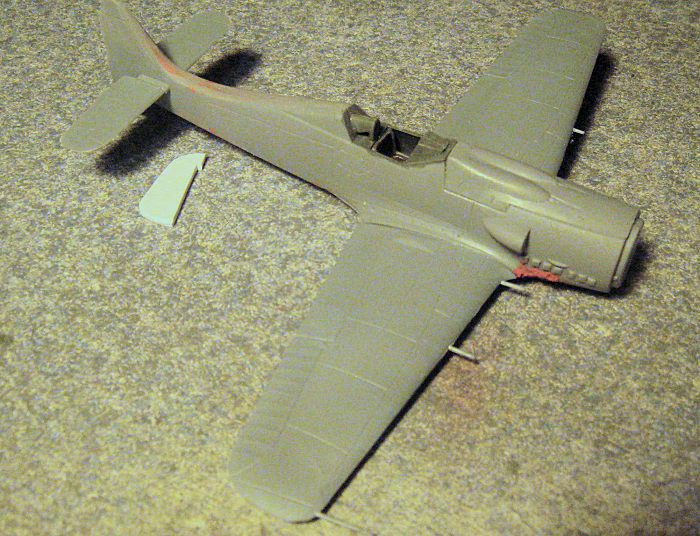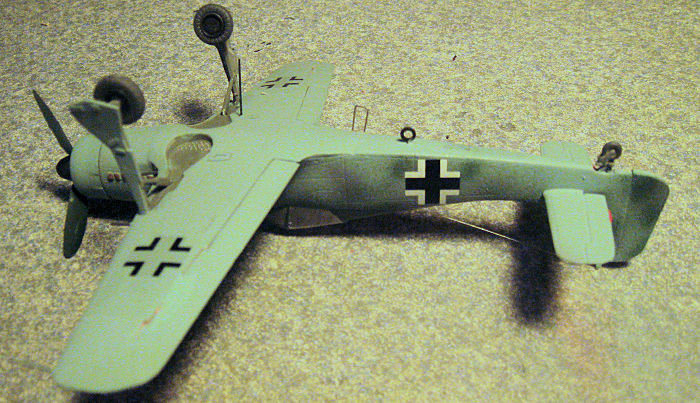
| KIT #: | 874 |
| PRICE: | $7.99 |
| DECALS: | Two options |
| REVIEWER: | Brian Baker |
| NOTES: | Kit is probably from the 1970s |

| HISTORY |
The Focke Wulf FW-190 was probably the best fighter used by
the German Luftwaffe during the course of World War II, and there is a wealth of
information available on the type in various resources. So much has been
published on the type that it is unnecessary to repeat it here. Over 20,000 were
built in numerous variants. Towards the middle of the war, the designer, Kurt
Tank, decided to improve the design to get better high altitude performance.
This meant using a new powerplant, the Junkers Jumo 213 liquid cooled engine.
Although prototypes were built and flown, Tank was not totally satisfied with
his design, but the type was already in production. However, improved versions,
designated TA-152C and TA-152H, were developed, and these were placed in
production at the end of the war, although they did not appear in quantities that made any difference in the outcome of the war. The FW-190D-9 and subsequent
versions was produced in quantity, but these were seen as temporary replacement
for the radial engine types until the TA-152ís became available.
that made any difference in the outcome of the war. The FW-190D-9 and subsequent
versions was produced in quantity, but these were seen as temporary replacement
for the radial engine types until the TA-152ís became available.
The FW-190D-9 was intended to follow the FW-190A-8 radial version, and although it became the major production version, small numbers of subsequent variants, designated FW-190D-10 through D-12 (Jumo 213), through FW-190D-14 and D-15 (DBN-603) were built, and tested. They were basically similar in appearance, and modelers can easily modify existing kits into any of the experimental variants.
There is a wealth of information available on the FW-190 series, and probably the best source is the Monogram Close-up series, with Vol. 10 covering the FW-190D series and Vol. 24 describing the TA-152 series. There are many other sources available, but I have found these to be the most udeful. In addition, there are numerous decal sets available providing good material for many of the colorful examples of the ďLong NoseĒ FW-190ís that were operational during the war.
| THE KIT |
There have been numerous kits produced of the FW-190 series in 1/72 scale, probably over 100 different kits since the sixties, dealing mostly with production models, although some prototypes can be made from them. Most kits are of the radial engine variants, although ďDĒ models have been produced by Lindberg, Airfix, MPM, Italeri, Hasegawa, Tamiya, Academy, and Hobby Boss. The Smer kit probably came out in the seventies, although there is no indication of this on the box top or kit instructions.The kit has been previewed by Scott in the kit previews section, but I havenít seen a kit build review. Originally, Smer kits were reissues of older kits, but this one is an original.
| CONSTRUCTION |
Using the FW-190D-9 kit, I built a model of the prototype FW-190-V56, which was one of the prototypes of the FW-190D-11. It was flight tested at the plant in Germany during August, 1944. I am not aware of its eventual fate, but it probably did not survive the war. There are a few photos available of the plane in various books, and itís an easy conversion.
 The kit
represents a standard FW-190D-9, but there are some major outline problems that
can be corrected without major surgery. Wingtip shape is too square, but this
can be rounded off with sandpaper. The rudder is hopeless, so I just
reconstructed one from card plastic, trimmed to the proper shape. There are no
aileron trim tabs, but these are inserted in the aileron rather than protruding
like they did on the real airplane. The major components are acceptable. The
cockpit interior is fairly visible through the canopy (both types are provided)
although I added a control stick. The forward fuselage gun deck fits quite well
in position, although this might be trimmed down on some variants that donít
have the fuselage mounted armament. Some filler is required for the major parts.
One weakness is the landing gear, which is not very substantial and the gear
legs are too thin. The gear doors or covers are very thin and on my kit, they
were warped, requiring bending back to a flat shape. The wheels are good,
however, although they should fit closer to the vertical strut.
The kit
represents a standard FW-190D-9, but there are some major outline problems that
can be corrected without major surgery. Wingtip shape is too square, but this
can be rounded off with sandpaper. The rudder is hopeless, so I just
reconstructed one from card plastic, trimmed to the proper shape. There are no
aileron trim tabs, but these are inserted in the aileron rather than protruding
like they did on the real airplane. The major components are acceptable. The
cockpit interior is fairly visible through the canopy (both types are provided)
although I added a control stick. The forward fuselage gun deck fits quite well
in position, although this might be trimmed down on some variants that donít
have the fuselage mounted armament. Some filler is required for the major parts.
One weakness is the landing gear, which is not very substantial and the gear
legs are too thin. The gear doors or covers are very thin and on my kit, they
were warped, requiring bending back to a flat shape. The wheels are good,
however, although they should fit closer to the vertical strut.
| COLORS & MARKINGS |
 Most
FW-190D-9ís were finished in standard Luftwaffe camouflage of two tone grey or
two tone green Luftwaffe numbered colors, with some mottled spots along the
fuselage and vertical surfaces. Many of the prototypes had a combination of
colors, which arenít readily noticeable in the black and white photos usually
published in books. You just have to use your imagination on that issue. As far
as markings go, aside from the regular crosses and tail swastikas, most types
had colored numbers or geometric patterns along the fuselage sides, with a werke
number printed high on the vertical stabilizer. I make black letters and numbers
on my computer, printing them on decal paper and spraying them with clear coat
before application.
Most
FW-190D-9ís were finished in standard Luftwaffe camouflage of two tone grey or
two tone green Luftwaffe numbered colors, with some mottled spots along the
fuselage and vertical surfaces. Many of the prototypes had a combination of
colors, which arenít readily noticeable in the black and white photos usually
published in books. You just have to use your imagination on that issue. As far
as markings go, aside from the regular crosses and tail swastikas, most types
had colored numbers or geometric patterns along the fuselage sides, with a werke
number printed high on the vertical stabilizer. I make black letters and numbers
on my computer, printing them on decal paper and spraying them with clear coat
before application.
| CONCLUSIONS |
Although I have heard many bad things about this kit, I wanted to build it for the experience. Aside from the outline errors, which I corrected, I assembled it pretty much as per instructions. As a result, it was fun, although it is not Haseqawa quality. But it looks klike an FW-190D, although my plane is the FW-190V-56 fighter prototype, as it appeared in August, 1944, during flight tests. Since I have a LOT of built FW-190ís in my cabinet, it fits in quite well. Itís not worth spending a lot of money on unless you are a serious kit collector, but if you can find one cheap, it will provide some entertainment. Not recommended for serious modelers.
Brian Baker
July 2023
Copyright ModelingMadness.com. All rights reserved. No reproduction in part or in whole without express permission from the editor.
If you would like your product reviewed fairly and fairly quickly, please contact the editor or see other details in the Note to Contributors.